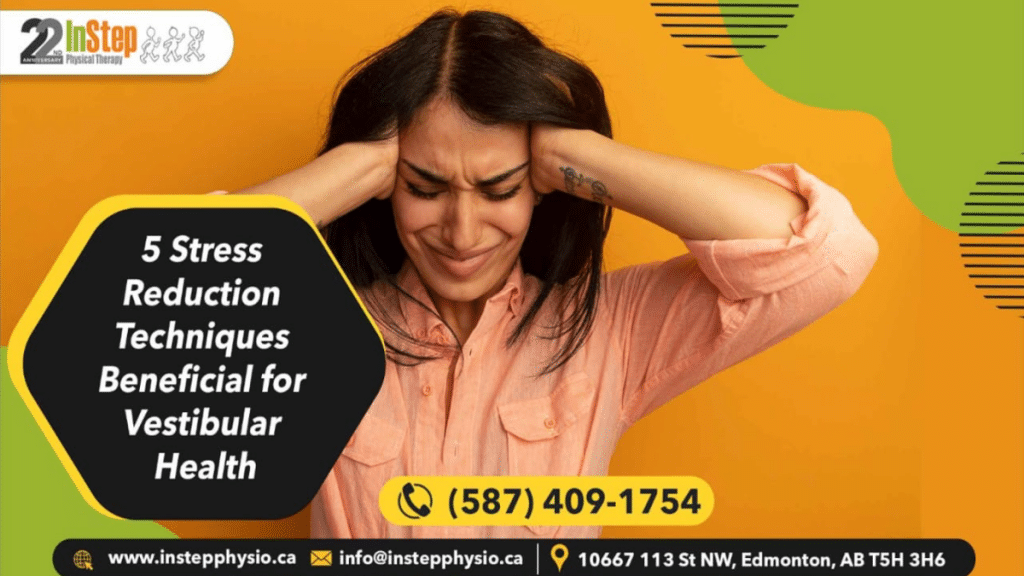The vestibular system is responsible for sustaining balance, spatial orientation, and coordinating eye movements. Vestibular rehabilitation therapy is typically prescribed to individuals who experience symptoms related to vestibular dysfunction, which can include vertigo (a sensation of spinning or dizziness), imbalance, nausea, and visual disturbances. Vestibular physiotherapy in Edmonton aims to address issues related to the vestibular system and significantly improve the quality of life.
5 Methods for Stress Reduction That Support Vestibular Well-being:
1. Deep Breathing Exercises:
Deep breathing techniques, like diaphragmatic breathing or belly breathing, can help minimize stress and promote relaxation. By concentrating on slow, deep breaths, you can activate the body’s relaxation response, which may help alleviate symptoms of vestibular dysfunction.
Diaphragmatic breathing:
This involves breathing deeply into the abdomen rather than the chest. Here’s how to do it:
- 1. Lie down comfortably or sit with your feet flat.
- 2. Place one hand on your abdomen and the other on your chest.
- 3. Breathe in slowly through your nostrils, sensing your abdomen expand.
- 4. Exhale gradually through your mouth or nose, noticing your abdomen fall.
- 5. Repeat for several minutes, focusing on the breath.
Paced Breathing:
Paced breathing involves breathing at a controlled and rhythmic pace to promote relaxation and reduce stress. A common paced breathing technique used in vestibular physiotherapy in Edmonton is the 4-7-8 breathing technique:
- Take a deep breath in through your nostrils, counting to 4 seconds.
- Pause your breath for a count of 7 seconds.
- Exhale gradually and fully through your mouth, counting to 8 seconds.
- Repeat this breathing pattern for several cycles, gradually increasing the duration if comfortable.
2. Mindfulness Meditation:
Engaging in mindfulness meditation entails directing your focus to the current moment without evaluation. This practice aids in minimizing stress and anxiety, which are common triggers for vestibular symptoms. Meditation techniques, such as body scan meditation or mindfulness of breath, can be particularly helpful in calming the nervous system and enhancing general wellness.
Body Scan Meditation:
This technique involves systematically bringing awareness to different parts of the body, beginning from the toes and moving upward to the head. During the body scan, individuals observe physical sensations without judgment or attachment. This practice can help promote relaxation, body awareness, and stress reduction, which are beneficial for managing vestibular symptoms.
3. Progressive Muscle Relaxation (PMR):
PMR is a relaxation method that entails tensing and subsequently relaxing various muscle groups throughout the body. By systematically tensing and releasing muscle tension, PMR helps promote physical relaxation and reduce overall stress levels. This method can particularly aid individuals with vestibular disorders, as it can help alleviate muscle tension and promote a sense of calm.
Systematic Muscle Tension and Relaxation:
Individuals are guided through systematically tensing and then relaxing different muscle groups in the body. This typically involves starting with the muscles in the feet and progressively moving upward through the legs, abdomen, arms, neck, and face.
Guided PMR Exercises:
Vestibular physiotherapists may lead clients through guided PMR exercises, providing verbal instructions and cues for tensing and relaxing each muscle group. Clients are encouraged to focus their attention on the feelings of tightness and release in every muscle set.
4. Yoga:
Yoga combines physical postures, breathing exercises, and meditation to promote relaxation and reduce stress. Certain yoga poses and sequences can be particularly beneficial for vestibular health, as they help improve balance, coordination, and body awareness. Gentle yoga practices, like restorative yoga or yoga nidra, can also promote relaxation and reduce stress without exacerbating vestibular symptoms.
Restorative Yoga:
Restorative yoga emphasizes relaxation and revitalization via gentle, supported postures maintained for prolonged durations. This practice can promote deep relaxation, reduce muscle tension, and alleviate stress without exacerbating vestibular symptoms.
5. Visualization and Guided Imagery:
Visualization and guided imagery techniques involve mentally visualizing peaceful and calming scenes or scenarios. By creating vivid mental images of tranquil environments or positive experiences, individuals can shift their focus away from stressors and promote relaxation, which can be beneficial for managing symptoms of vestibular disorders.
Safe and Secure Spaces:
Clients may be encouraged to visualize a safe and secure space, such as a cozy room or a favourite place from their past where they felt comfortable and at ease. They are guided to imagine the details of the space and to evoke feelings of safety and relaxation.
Nature Scenes:
Individuals may be guided to visualize peaceful and tranquil natural environments, such as a serene beach, a calm forest, or a tranquil mountain lake. They are encouraged to engage their senses by imagining the sights, sounds, smells, and sensations associated with these environments.
Navigating Balance:
Vestibular physiotherapy in Edmonton stands as a beacon of optimism for individuals seeking relief from the burdens of vestibular dysfunction compounded by stress. Through a multifaceted approach encompassing specialized exercises, relaxation techniques, and mindfulness practices, In Step Physical Therapy in Edmonton not only targets the physical manifestations of vestibular disorders but also addresses the intricate interplay between stress and symptoms. By fostering a harmonious balance between body and mind, vestibular rehabilitation therapy empowers individuals to navigate their journey toward wellness with resilience and confidence. As stress levels diminish and inner peace is cultivated, the transformative impact of vestibular rehabilitation extends far beyond symptom management, enriching lives and restoring a sense of equilibrium to those who embark on this transformative path.
